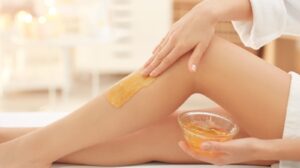Table of Contents
Sugar Waxing: A Natural, Healthier Alternative for Smooth Skin
Many people seek gentle yet effective ways to manage body hair, especially during warmer months or special outings. Traditional hair removal techniques, like hot waxing or shaving, often cause skin irritation. Luckily, there’s an alternative that’s growing in popularity — sugar waxing, also known as “sugaring.”
What is Sugar Waxing?
Sugar waxing is an age-old technique used to remove body hair. Originating in ancient Egypt and Greece, this natural waxing method involves a blend of simple ingredients: sugar, water, lemon juice, and sometimes honey. Unlike traditional waxes, sugar wax adheres to the hair rather than the skin, reducing pain and skin irritation.

Sugar Waxing: A Natural Method for Smooth Skin
The Health Benefits of Sugar Waxing
Sugar waxing is known to be gentler on the skin, making it suitable for those with sensitive skin. Additionally, because it doesn’t strip away the skin’s natural oils, it helps maintain the skin’s moisture balance. This can be a better choice for people prone to dryness or razor burns.
How Does Sugar Waxing Work?
Similar to other types of waxing, sugar wax is applied to the skin and then removed, taking body hair with it. However, the key difference is that sugar binds to the hair instead of the skin. For the best results, the hair should be about a quarter of an inch long, allowing the sugar paste to adhere effectively.
Is Sugar Waxing Less Painful?
Since sugar wax only binds to the hair and not the skin, the removal process is often less painful than traditional waxing. This can make a significant difference, especially for those with low pain tolerance or sensitive skin. While some discomfort may still be felt, it is usually less intense than hot waxing.
Comparing Sugar Waxing and Traditional Waxing
For individuals with sensitive skin, sugar waxing is often a preferred alternative to traditional waxing. Unlike synthetic waxes, sugar wax contains no artificial chemicals or petroleum-based ingredients. The natural ingredients in sugar wax also make it biodegradable, contributing to its eco-friendliness.
Exfoliating Properties
Sugar wax naturally exfoliates the skin, removing dead skin cells alongside the hair. This helps in achieving a smooth and radiant appearance post-waxing. Moreover, the sugar acts as a gentle scrub, ideal for areas prone to dryness and flakiness.
How Long Does the Smoothness Last?
According to experts, sugar waxing can leave skin smooth for up to six to eight weeks. This timeframe can vary depending on individual hair growth cycles. Interestingly, the hair that grows back after sugaring tends to be finer and softer, which can make future waxing sessions easier and less painful.
Sugaring Techniques: Choosing the Right Method
There are two primary techniques for applying sugar wax:
- Hand Application: Roll a ball of sugar paste and apply it to the skin, removing it by pulling in the opposite direction of hair growth.
- Cloth Strips: Spread the sugar wax thinly, place a cotton strip on top, and then pull it off in the same direction as hair growth.
For beginners, using cloth strips may be easier, while experienced users may prefer the hand application method as it can offer more precision and control.
DIY Sugar Wax Recipe
Ingredients
- 1 cup granulated sugar
- 2 tablespoons lemon juice
- 2 tablespoons water
- 1 tablespoon honey (optional)
Preparation
Start by heating the lemon juice and water on medium heat in a pan. Add the sugar and honey, and stir until it reaches a smooth, golden consistency. Monitor the mixture’s temperature — ideally, it should reach about 250°F. Once done, let it cool to a manageable temperature.
Preparing Your Skin
Before applying the sugar wax, ensure your skin is clean and dry. Hair should be around 1/4 to 1/2 inch long for optimal results. Exfoliating with a gentle scrub beforehand can help the wax adhere better to the hair, making the process more effective.
Patch Testing
Always perform a patch test on a small area of skin to ensure there’s no adverse reaction. Although sugar waxing is typically gentle, it’s essential to check if your skin tolerates it well. If there’s no irritation, you’re ready to proceed.
Using Sugar Wax
Hand Method
- Scoop a portion of the wax, stretch it until it becomes opaque, and apply it to the skin against the direction of hair growth.
- Hold the skin taut, then quickly pull the wax in the direction opposite to hair growth.
Cloth Strip Method
- Apply a thin layer of wax in the direction of hair growth.
- Place a cloth strip over the wax, press down, then pull in the same direction as hair growth.
Aftercare Tips
Once you’re done waxing, rinse with warm water to remove any remaining sugar. Apply a natural moisturizer like aloe vera to soothe the skin. Avoid hot showers, saunas, and vigorous activities for 24 hours to let your skin recover.
Long-Term Skin Health
Regular exfoliation and moisturizing between sessions can keep the skin soft and prevent ingrown hairs. Consider exfoliating 48 hours post-waxing to remove dead skin cells and maintain smoothness.
Potential Risks
While sugar waxing is generally safe, it’s best for softer hair. Areas with coarser hair, like the underarms and bikini line, may be more challenging. If you’re unsure, consult a professional.
When to Avoid Sugar Waxing
Avoid sugar waxing on irritated or sunburned skin. Also, those with skin conditions like eczema should consult a dermatologist before trying this method.
Final Thoughts: Why Sugar Waxing May Be Right for You
With benefits like natural ingredients, gentle exfoliation, and prolonged smoothness, sugar waxing is a skin-friendly choice for hair removal. By following the steps above, you can achieve silky skin at home while minimizing pain and irritation.